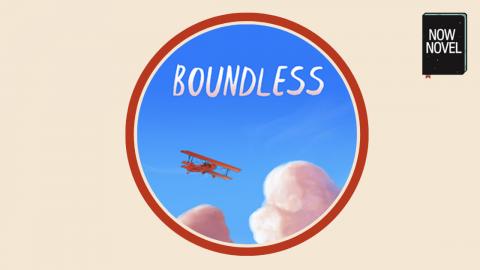In this interview with the creator of Boundless the comic, Mike Salsbury, we discuss writing comics, visual storytelling influences, process and building a reading audience.
Writing comics: Inspirations
Jordan:
Thank you for reaching out to us, Mike. I’m curious to learn more about the world of Boundless.
Comics and graphic novels are an eclectic and interesting medium. I grew up loving my grandfather’s collection of Peanuts comics, reading Asterix, Calvin and Hobbes and many others every night in bed before I fell in love with novels. So I was immediately drawn to similar elements of wanderlust and questioning (for want of a better word) when I saw Boundless.
What drew you to this medium, and what have been some of your own visual story influences/inspirations?
Mike Salsbury:
As a kid I was also a big fan of Calvin and Hobbes by Bill Waterson. I was fascinated by how well the characters were drawn, and by the large personalities in each frame.
Over time I was moved and inspired by larger motion pictures by Steven Spielberg and PIXAR Inc. The Spielberg films amazed me because he always did a great job of making you forget you were watching a film. Falling quickly into the story without realizing it.
The Pixar Team influenced me because of the believable worlds they created. A Pixar film is an art piece itself, but all of the sketches and scraps that get left behind are overlooked by a lot of folks. It was where most of the storytelling inspiration was for me.
2. The comic-writing process
Jordan:
Something we love to discuss here is the process of finding ideas, as well as the writing process itself.
I’m curious to know, how do you develop the storylines and each episode when writing comics?
Do you storyboard visually first? Write the idea for the episode as text? Do you keep documents of character details such as backstory or future planned developments? Or see where the story takes you (‘pantsing’)?
Or is it a combination of planning and pantsing? Please describe your process to us a little.
Mike:
For me ideas arise when I am balanced with; work, life, and exercise. It also helps to not force or rush the plot.
I love setting things on the “back burner” and letting the idea simmer. If the idea is worth sticking to, It keeps popping up.

Otherwise I just forget about it. These days I have had to take on a different creative process than when I originally started with Boundless. Before, I sketched on paper, and then digitally worked on top of it. This took way too long. Now I write out the text and describe the shot in a quick sentence.
This way when I work on my digital canvas I can film and photo reference as I go when I illustrate. It leaves a lot more creative room.
3. Natural environments in story settings
Jordan:
You’ve rendered outdoor settings and environments beautifully – could you speak a little about ‘nature’ in Boundless?
How does nature or environment factor into the stories you tell? Is there a particular message you think about regarding environment or ecology, our human relationship with animals?
I loved instances where Emily tries to ‘tame’ Rudy the fox by making suggestions he does certain things and he resists this.
A post shared by Mike Salsbury (@mike__salsbury)
Mike:
Thanks! I lived in the Adirondacks as a teenager. I spent a lot of time trekking through rivers to fly fish, and hiking in the woods with my dog. It was so silent and peaceful.
All of that influence helped me recognize that the environment in a story is just as important as the focal point. Kind of like the bass player and the drummer in a band. They aren’t out front, but they are holding the majority of the song.
We should try and save this planet before we try and search for others, but I don’t try to make any ecological points in the story. As far as resistance to taming goes, I think we all have that in our own ways. Human or fox.
4. Identifying your reader base
Jordan:
I loved the wording of the call to action on your site, specifically ‘This adventure is built solely on the support of; patrons, dreamers, and adventurers.’
One could describe the art style of Boundless as ‘dreamy’, for sure. What is your definition of being a dreamer and being an adventurer? What makes these categories or ‘ways of life’ important to you (or your reader base)?
Mike:
I think being a dreamer is as simple as being someone who is open, but also understands the commitment and hard work it takes to realize their dream with others.
We’re all dreamers at some point, usually in childhood. For some reason or another people tend to make that commitment to stick to the dream or let it go. Not to say they can’t dream again.
5. Story structure in writing comics
Jordan:
I like the way you’ve structured sections of Boundless into ‘episodes’ on your website. Are TV or other animated cartoons particular influences?
Mike:
Definitely! I would refer back to the Pixar influence. Their animations and relationships are timeless. I would say films like, “Ratatouille,” “Up,” and “Monsters Inc.” influenced me.
All of these movies had amazing duos who complimented each other. Usually directed by Pete Doctor, who has mastered this element of storytelling.
6. Whimsy and the surreal
Jordan:
Speaking of episodes and animation, growing up I loved cartoons such as TailSpin with its aviation theme, and I noticed the flight goggles you’ve carried over into different representations of Rudy the talking fox.
I think of Snoopy the dog with his Sopwith Camel WWI fighter plane in Charles M. Schulz’s comics. There’s a wonderful element of the whimsical and surreal in this.

What do whimsy and the idea of the surreal, of blending the factual (a fox being a fox, for example) and the imaginative (a talking fox putting on your roomate’s top and going downstairs to make coffee, to use one example from the comic) mean to you?
Mike:
That’s a good question.
I want to let in just enough imagination so that people aren’t overwhelmed. This way I can keep the characters relatable, and bring out the reader’s “inner adventurer.”
My goal is to get readers of all ages involved, not just a specific demographic.
7. Socially conscious platform use
Jordan:
I noticed in a recent panel you shared to Instagram, there’s a strong message about an ethics of care, when Rudy says ‘At St. Judes, families never receive a bill for treatment, travel, housing or food – because all they should worry about is helping their child live.’
This post speaks to what I see as big ‘heart’ to the project. It connects with the socially-conscious, empathic dreamer.
Would you say social justice is important to your storytelling decisions?
Mike:
I want to say no but that sounds pretty bad.
If I were a social justice creator I probably would have become a political cartoonist. I try to put more emphasis on my characters from a philosophical and funny standpoint.
Now that the story is growing I have some influence to help others. I’m not here to tell anyone else they have to contribute, but whenever I decide to help others I never regret it. I think everyone deserves the chance to help someone if they want.
8. On interactive storytelling in comics
Jordan:
Interactivity and VR or augmented reality have grown in recent times, especially as our lives are more and more digital (under the COVID pandemic too).
So there was a sense of delight in discovering the interactive globe mapping episodes of Boundless to real world locations on your website.
What do you think about interactive storytelling? Talk me through your thought process for including this as a way to interact with the world of Boundless.
Mike:
Interactive storytelling should always be the beginning move of every writer.
For Boundless, I think it’s kind of the lifeline of the story. It gives the sense that the series is a living breathing document. The globe I created was to help people understand how far these characters are going.
It’s also another way we can all relate as Rudy and Emily will be traveling throughout the globe. A lot of the readers are international, so I get a lot of requests for the characters to go to specific countries. It’s fun to watch everyone get so excited to welcome these characters to their home.

9. On building an audience
Jordan:
Many creatives like yourself are leveraging social media and patronage platforms such as Patreon to build their own tribe of supporters passionate about what they do.
Do you have any advice for people who want to get their stories out there? Is there anything major you’ve learned from this part of the process (the challenges of audience-building)?
Mike:
First I would say that focusing on your story and your characters is a priority.
Second is to have fun while doing so. It’s a vocational decision to live on your own terms, not a financial one. You’ll be spending the majority of your life working around your craft. So if you’re not a super nerd about it you’ll burn out.
There are a lot of folks out there who will try and sell you advice on how to grow your fan base, but in the end it comes down to whether or not someone felt something from your story.
For an example; I make typos all the time (trust me, my readers let me know), but people still felt something from Boundless and wanted to be a part of it regardless of the errors.
For platforms like Patreon make sure you add value through strong storytelling. Think in decades, not months when it comes to building your community.
10. Advice for writing comics
Jordan:
Lastly, I’d love to know what advice you’d have for aspiring illustrators and storytellers who want to create comics, graphic novels or other visual storytelling of their own.
Mike:
I would recommend focusing on your:
- Storytelling
- Character development
- and illustration skills.
A lot of people try to grow an audience just off of their own desire to tell stories or write comics and have learned that we need to really add value to our readers through entertainment. I keep thinking my next strategy to convert sales or patrons will make all the difference.
I learned that just posting another episode was really the determining factor of a few more contributors or customers.
Jordan:
Thank you for speaking with us about Boundless, Mike, as well as your creative process, and for sharing your advice.
About Mike:

Mike Salsbury is the creator of the weekly comic strip Boundless. His goal is to bring stories to life. He loves helping other artists and clients to achieve their goals.


2 replies on “Writing comics: Q&A with the creator of Boundless”
so sorry, I meant to update you that it was mike__salsbury. If you dont update i understand. My mistake!
Hi Mike, thank you, I’ve updated the article!